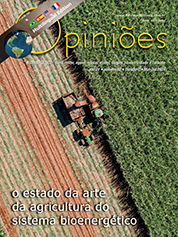Rodrigo Simonato
Gerente-Executivo de Relações Institucionais da Tereos Açúcar e Energia Brasil
OpAA80
A efetiva ruptura de limites
Coautoras: Suzeti Jara Ferreira, Diretora de Marketing da Tereos Açúcar e Energia
Imaginar em atingir e manter a produção da cana-de-açúcar em 100 toneladas por hectare, o que hoje até parece simples, não poderia ser sem que toda a inovação e evolução, nos últimos 50 anos, do setor sucroenergética não tivesse sido trilhada por grandes nomes, que construíram a melhor e maior produção do agronegócio em todo mundo.
Destes nomes, com certeza, o Centro de Tecnologia Canavieira (CTC) é um exemplo emblemático de pioneirismo e inovação na cultura da cana-de-açúcar. Criado originalmente em 1969 como parte do Instituto do Açúcar e do Álcool, o CTC tornou-se uma referência em pesquisa e tecnologia, desempenhando um papel crucial no desenvolvimento de novas tecnologias e variedades de cana mais produtivas e resistentes. O CTC também tem um papel como modelo de governança. Tudo somado garantiu a evolução da produtividade das 100 toneladas por hectare.
Esta maior produção por unidade de área é historicamente um indicador-chave avaliado em qualquer tipo de cultivo uma vez que afeta diretamente o fluxo de caixa, aumentando receita e diluindo custos fixos. Nos últimos 15 anos, a média móvel da produtividade dos principais cultivos no agronegócio brasileiro tem apresentado diferentes tendências, uma vez que essa simples relação é derivada de uma complexa combinação entre manejo, velocidade na adoção de novas tecnologias, questões conjunturais específicas, movimentos expansionistas, dentre outros fatores intrínsecos em cada mercado.
De modo geral, as culturas de milho e soja têm apresentado ganhos médios em produtividade de aproximadamente 40% e 20% respectivamente. Em contrapartida, para o cultivo de cana-de-açúcar verifica-se uma tendência diferente, que reflete, dentro desse contexto histórico, o impacto da ocorrência de uma série de fatores detratores de produção como a intensificação da mecanização da colheita e do plantio, endividamento setorial, consolidação de grupos empresariais e aumento de escala produtiva, a expansão do cultivo em ambientes de produção mais restritivos e pouco adaptados às variedades até então disponíveis, aumento exponencial da intensidade de pragas e plantas daninhas, etc, que impuseram o grande desafio de romper o patamar de produtividade setorial.
A efetiva ruptura de produtividade se dá na celeridade de adoção de novas tecnologias atreladas aos ganhos da pesquisa e ao desenvolvimento de novos produtos. Nesse sentido, o CTC – Centro de Tecnologia Canavieira tem a visão de dobrar a produtividade dos canaviais brasileiros em 20 anos.
Essa visão é embasada em quatro pilares estratégicos:
1. Mais potencial: endereçado pelo melhoramento genético e pela seleção de variedades de cana com maior potencial produtivo. Nesse sentido, esse pilar é suportado por uma série de diferenciais e investimentos que visam dar continuidade aos ganhos genéticos consistentes de, pelo menos, 3% a.a em toneladas de açúcar por hectare. Dentre esses diferenciais destacam-se:
1. A manutenção do maior banco de germoplasma do mundo, localizado no sul da Bahia, com mais de 5.500 variedades;
2. Mais de 1.500 cruzamentos realizados anualmente atendendo aos diferentes objetivos regionais;
3. Programa de melhoramento ocorrendo simultaneamente em 7 regiões produtoras do Brasil, buscando a seleção de materiais regionais, adaptados às condições de solo e clima específicos;
4. Pipeline ágil e robusto que encurta o processo clássico de 15 para 8 anos, permitindo uma entrega mais rápida e assertiva de variedades para o setor canavieiro;
5. Mais de 200 ensaios plantados por ano buscando desenvolver e avaliar a interação genótipo – ambiente dos materiais promissores;
6. Ênfase na sanidade e resistência a doenças com novas estratégias e metodologia de avalição, promovendo a seleção de um maior número de clones com alta sanidade;
7. Incorporação de genitores mais jovens, capturando maiores níveis de ganhos genéticos; e
8. Otimização da gestão de dados digitais e uso de inteligência artificial, permitindo a geração do maior banco de variedades genotipadas no mundo possibilitando aprofundamento na compreensão genética da cana-de-açúcar, refletindo, por consequência, na seleção mais assertiva de variedades.
3. Mais adaptado: vinculado ao manejo agronômico que permita a expressão de todo o potencial produtivo das variedades. Nessa frente, atua-se desde o posicionamento correto das variedades até o uso de equipamento menos agressivos aos canaviais, agricultura digital, novas formulações etc.
O Centro de Tecnologia Canavieira não é apenas um exemplo de sucesso em pesquisa e inovação no agronegócio, mas também um modelo de como a governança e o envolvimento estratégico do setor privado podem impulsionar o desenvolvimento sustentável.
A história do CTC e sua contribuição para a evolução da agricultura no Estado de São Paulo são indicativos de como a pesquisa aplicada e uma gestão eficaz podem resultar em avanços significativos para o agronegócio brasileiro como um todo. Seu legado serve como um valioso paradigma para outros setores em busca de modernização e sustentabilidade.




